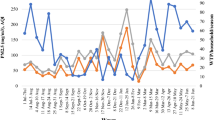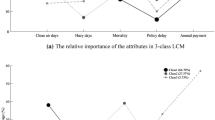Abstract
This paper presents the multilevel model approach to analyzing contingent valuation surveys of individuals’ willingness to pay for reductions in the level of air pollution. It is likely that individuals living in the same area are exposed to the same level of air pollution, and accordingly these individuals’ valuations of a reduction may be correlated. Thus, the data have a hierarchical structure with individuals clustered within regions, and this structure violates the general assumption of independence among observations. Multilevel models allow for this type of data structure. In this paper we analyze individuals’ stated willingness to pay in an open-ended contingent valuation survey for a reduction in the local level of air pollution in Sweden. The results suggest that most variations are among individuals. However, our results indicate that there are also variations at higher levels, which may be explained by homogeneous preferences for a reduction in air pollution among individuals living in the same household or region with a similar level of air pollution.
Similar content being viewed by others
References
Alberini A, Cropper M, Fu T, Krupnick A, Liu J, Shaw D, Harrington W (1997a) Valuing health effects of air pollution in developing countries: the case of Taiwan. Journal of Environmental Economics and Management 34:107–126
Alberini A, Kanninen B, Carson T (1997b) Modelling response incentive effects in dichotomous choice contingent valuation data. Land Economics 73:309–324
Carlsson F, Johansson-Stenman O (1999) Willingness to pay for improved air quality in Sweden. Applied Economics 32:661–668
Diamond P, Hausman J (1994) Contingent valuation: is some number better than no number? Journal of Economic Perspective 8:45–64
Duncan C, Jones K, Moon G (1996) Health-related behaviour in context: a multilevel modelling approach. Social Science and Medicine 42:817–830
Flood L, Olovsson P (1999) Household market and nonmarket activities (HUS): survey description 1996 panel survey. Department of Economics, Gothenburg University
Goldstein H (1987) Multilevel models in educational and social research. Charles Griffen, London
Goldstein H (1995) Multilevel statistical models. Edward Arnold, London
Goldstein H, Rasbash J, Plewis I, Draper D, Brown W, Yang M, Woodhouse G, Healy M (1998) A user’s guide to MLwiN. University of London, London
Halvorsen B (1996) Ordering effects in contingent valuation surveys: willingness to pay for reduced health damage from air pollution. Environmental and Resource Economics 8:485–499
Halvorsen B, Saelensminde K (1998) Differences between willingness-to-pay estimates from open-ended and discrete-choice contingent valuation methods: the effects of heteroskedasticity. Land Economics 74:262–282
Hsiao C (1986) Analysis of panel data. Cambridge University Press, Cambridge
Johansson C, Hadenius A, Johansson P-Å, Jonsson T (1999) SHAPE The Stockholm study on health effects of air pollution and their economic consequences. Part I. NO2 and particulate matter in Stockholm: concentrations and population exposure. AQMA Report 6:98. Swedish National Road Administration, Stockholm, 1999, 41
Jones K (1991) Multi-level models for geographical research. Geobooks, Norwich, UK
Kriström B (1993) Comparing continuous and discrete contingent valuation questions. Environmental and Resource Economics 3:63–71
Langford I, Bateman I (1999) Multi-level modelling and contingent valuation. In: Bateman I, Willis K (eds) Valuing environmental preferences. Oxford University Press, Oxford, pp 442–459
Langford I, Bateman I, Jones A, Langford H, Georgiou S (1998a) Improved estimation of willingness to pay in dichotomous choice contingent valuation studies. Land Economics 74:65–75
Langford I, Kontogianni A, Skourtos M, Georgiou S, Bateman I (1998b) Multivariate mixed models for open-ended contingent valuation data. Environmental and Resource Economics 12:443–456
Mitchell R, Carson R (1989) Using surveys to value public goods: the contingent valuation method. Resources for the Future, Washington, DC
Rice N, Jones A (1997) Multilevel models and health economics. Health Economics 6:561–575
Scott A, Shiell A (1997) Analysing the effect of competition on general practitioners’ behaviour using a multilevel modelling framework. Health Economics 6:577–588
Author information
Authors and Affiliations
About this article
Cite this article
Carlsson, F., Martinsson, P. Willingness to pay for reduction in air pollution: a multilevel analysis. Environ Econ Policy Stud 4, 17–27 (2001). https://doi.org/10.1007/BF03353969
Received:
Accepted:
Published:
Issue Date:
DOI: https://doi.org/10.1007/BF03353969




